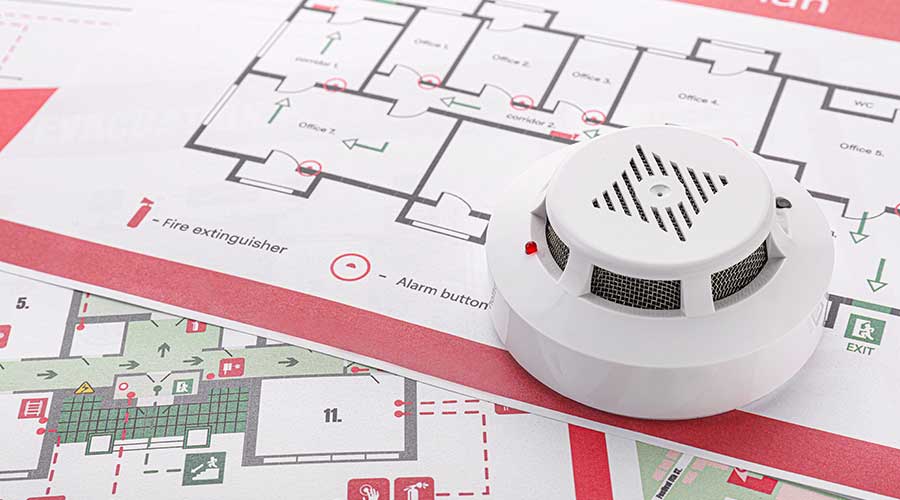Safety drills matter to healthcare facilities since they not only house critical healthcare personnel, but potentially vulnerable patients. These patients may not be able to move on their own during a crisis situation or could injure themselves by doing so. As such, it is important to practice for these scenarios.
Case in point: fire safety drills. However, how do healthcare facility managers begin planning their drills?
"First they need to understand what codes apply to their facility and I think that can become a place to start,” says Larry Rietz, global service line leader for fire detection and alarm at Jensen Hughes. “Most facilities operate under National Fire Protection Association (NFPA) 101, though healthcare facilities may operate under additional codes or even local codes. That can be a place to start because it is best to know what you are required to do. Additionally, in those codes there is a lot of explanatory language that that can help them.”
Healthcare facilities not only have to abide by those codes, but they also have to follow the standards set out by the Joint Commission. In fact, every year a healthcare facility has to undergo an inspection and pass it to still receive Medicare and Medicaid funding. If a healthcare facility does not pass, it means losing out on crucial sources of funding.
“Healthcare facilities have some of the highest requirements for inspection and appropriately so. There are a lot of dangerous things that happen in hospitals,” says Rietz. “So, they have a lot of requirements for inspections and a lot of mandates are put on them. It becomes very important to these facilities to keep things up to code.”
These codes also influence the planning for fire drills.
“For instance, the 2021 edition of NFPA 101, which is the Life Safety code, says for a new hospital you have to have evacuation and relocation plans for fire drills,” says Rietz. “So, it actually tells you and it says fire drills in healthcare occupancies shall include the simulation of emergency fire conditions and including the activation of the fire alarm system notification appliances.”
Communication/notification around the fire drills or actual fires is done in a coded language. The code used varies depending on the healthcare facility. This is done so that patients or visitors do not do anything that may put their own safety at risk. That is one reason healthcare facilities handle fire drills differently.
In addition, the very environment and people of these facilities are enough to set healthcare apart from other buildings.
“Healthcare differs greatly from other building types because they often rely on either a partial evacuation or relocation strategy. Sometimes, there is even a shelter in place or what is called a defend in place strategy in healthcare,” says Rietz. “That is very, very different than a business occupancy where an incident happens and your job is to get out or in an educational occupancy where a fire alarm goes off and the children need to egress.”
That defend in place strategy is where building employees, who have undergone training, provide protection and safety for their inhabitants. It also incorporates various structures within the facility to defend against the emergency, or in this case, the fire.
“A healthcare facility is often segregated into smaller zones. Those zones are built with protection in inside the zone, like smoke barriers or even fire barriers,” says Rietz. “So, when an event happens somewhere in a healthcare facility the building itself becomes a bunch of little buildings in a sense. Let’s say you have a floor of a healthcare facility that has two zones. If a fire occurs in Zone A, then the emergency evacuation procedure may be to remove the occupants of Zone A over into Zone B.”
Frequency is important for fire drills. According to the NFPA 101-2021 Edition, for new and existing healthcare occupancies: “Drills shall be conducted quarterly on each shift to familiarize facility personnel (nurses, interns, maintenance engineers, and administrative staff) with the signals and emergency action required under varied conditions.”
Additionally, Rietz says it will depend upon the shift schedules and facility type. Rietz also notes that the NFPA 101-2021 Edition says for healthcare facilities to issue a coded announcement if a fire drill occurs between 9 p.m. and 6 a.m. This is so bedridden patients and others with limited movement do not have to get up and move around.
Fires, like any other emergency, require in-depth and rigorous training to prepare for. If done right, these drills can prepare staff to protect patients and others from danger.
Jeff Wardon, Jr., is the assistant editor for the facilities market.

 Contaminants Under Foot: A Closer Look at Patient Room Floors
Contaminants Under Foot: A Closer Look at Patient Room Floors Power Outages Largely Driven by Extreme Weather Events
Power Outages Largely Driven by Extreme Weather Events Nemours Children's Health Opens New Moseley Foundation Institute Hospital
Nemours Children's Health Opens New Moseley Foundation Institute Hospital Code Compliance Isn't Enough for Healthcare Resilience
Code Compliance Isn't Enough for Healthcare Resilience Ribbon Cutting Marks First Phase Completion for New Montefiore Einstein Facility
Ribbon Cutting Marks First Phase Completion for New Montefiore Einstein Facility